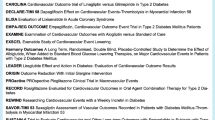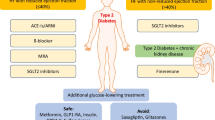Abstract
Background
Patients with type 2 diabetes and heart failure are considered to be at high risk for hypoglycaemic complications. There is a considerable uncertainty with respect to the appropriate choice of antidiabetic pharmacotherapy in patients with type 2 diabetes and comorbid heart failure. Little is known about comorbidity, hypoglycaemia rates and selected pharmacotherapy in diabetic patients with heart failure in clinical practice.
Methods
DiaRegis is a prospective registry in Germany including 3,810 patients with type 2 diabetes receiving antidiabetic treatment with oral mono or oral dual combination therapy in 2009/2010. Only patients for which adjustment of pharmacotherapy (including the introduction of insulin and GLP-1 analogues) was deemed necessary were enrolled. We examined the differences in comorbidity, hypoglycaemia and choice of anti-diabetic pharmacotherapy between diabetics with and without clinical heart failure in clinical practice in Germany.
Results
For 3,746 patients, data on the presence of heart failure were available, median (IQR) age 65.9 (57.6–72.8) years and 46.8% were female. Patients with heart failure (n = 370; 9.9%) were older, had a higher BMI, were less physically active, and had more cardiovascular risk factors and a substantial comorbidity. Glycaemic control was comparable between groups. Of the patients with heart failure, 76.8% received metformin, 32.7% sulfonylureas, 2.2% glucosidase inhibitors, 4.3% glinides, 6.2% glitazones and 7.3% DPP-4 inhibitors at baseline before adjustment of therapy. In multivariate analyses, patients with heart failure received less metformin (odds ratio (OR) 0.58, 95% confidence interval (CI) 0.43–0.79) and sulfonylureas (OR 0.70, 95%CI 0.52–0.95) but not thiazolidinediones (OR 1.22, 95%CI 0.82–1.81) or other antidiabetic drugs. Hypoglycaemia was considerably more frequent in diabetic patients with heart failure than in those without (OR 1.96, 95%CI 1.47–2.61).
Conclusion
Patients with type 2 diabetes and heart failure had a substantially increased comorbidity burden compared to patients without heart failure. They more often suffered from episodes of hypoglycaemia, especially those requiring medical assistance. The diagnosis of heart failure did not impact the choice of antidiabetic pharmacotherapy in patients with type 2 diabetes. There was no differential use of thiazolidinediones despite evidence discouraging their use in patients with heart failure.
Zusammenfassung
Hintergrund
Patienten mit Typ-2-Diabetes und Herzinsuffizienz haben ein erhöhtes Risiko für Hypoglykämien. Im klinischen Alltag besteht häufig Unsicherheit bezüglich einer adäquaten antidiabetischen Therapie bei Patienten mit zusätzlicher Herzinsuffizienz, und es existieren nur wenig Daten zur Komorbidität, zu Hypoglykämieraten sowie zur gewählten antidiabetischen Therapie von Patienten mit Diabetes und Herzinsuffizienz.
Methodik
DiaRegis ist ein deutsches prospektives Register. Von 313 niedergelassenen Ärzten wurden in den Jahren 2009/2010 insgesamt 3810 ambulant behandelte Patienten mit Typ-2-Diabetes und antidiabetischer oraler Monotherapie oder oraler dualer Kombinationstherapie eingeschlossen, bei denen der behandelnde Arzt bei Aufnahme in das Register eine Anpassung der antidiabetischen Therapie vornahm (inklusive der Gabe von Insulin oder GLP-1Analoga). Wir untersuchten Unterschiede in der Komorbidität, der Hypoglykämierate sowie der antidiabetischen Pharmakotherapie bei Patienten mit und ohne klinische Zeichen einer Herzinsuffizienz im klinischen Alltag in Deutschland.
Ergebnisse
Bei 3746/3810 Patienten lagen Daten zur Herzinsuffizienz vor. Das mediane Alter betrug 65,9 Jahre (Interquartilenabstand 57,6–72,8); 46,8% der Patienten waren Frauen. Eine Herzinsuffizienz war bei 370 Patienten (9,9%) vorbeschrieben. Diese Patienten waren älter, hatten einen höheren BMI, waren körperlich weniger aktiv und hatten signifikant mehr kardiovaskuläre Risikofaktoren sowie deutlich mehr Begleiterkrankungen. Es fanden sich keinerlei Unterschiede in der Blutzuckerkontrolle, gemessen als HbA1c, Nüchtern- oder postprandiale Plasmaglukose, zwischen Patienten mit bzw. ohne Herzinsuffizienz. Die Rate der Hypoglykämien in den 12 Monaten vor Einschluss in das Register war bei Patienten mit Herzinsuffizienz signifikant erhöht (OR 1,96; 95%-KI 1,47–2,61). Die Pharmakotherapie des Diabetes war bei Patienten mit Herzinsuffizienz zum Zeitpunkt des Einschlusses in das Register vor Therapieanpassung dominiert von Metformin (76,8%), gefolgt von Sulfonylharnstoffen (32,7%), Glukosidaseinhibitoren (2,2%), Gliniden (4,3%), Glitazonen (6,2%) und DPP-4-Inhibitoren (7,3%). Nach Korrektur für die Unterschiede in den Patientencharakteristika mittels multivariater Analyse erhielten Patienten mit Herzinsuffizienz seltener Metformin (OR 0,58; 95%-KI 0,43–0,79) und Sulfonylharnstoffe (OR 0,70; 95%-KI 0,52–0,95). Keine Unterschiede zu Patienten ohne Herzinsuffizienz fanden sich bei Einsatz der anderen antidiabetischen Therapien, insbesondere auch nicht für Thiazolidindione (OR 1,22; 95%-KI 0,82–1,81).
Schlussfolgerungen
Im klinischen Alltag in Deutschland waren Patienten mit Typ-2-Diabetes und Herzinsuffizienz im Vergleich zu Diabetikern ohne Herzinsuffizienz durch eine deutlich größere Komorbidität geprägt. Trotz gleicher HbA1c-Einstellung hatten diese Patienten signifikant mehr Hypoglykämien, insbesondere solche, die medizinische Hilfe benötigten, als Patienten ohne Herzinsuffizienz. Die Herzinsuffizienz hatte keinerlei Einfluss auf die Auswahl der antidiabetischen Therapie des Typ-2-Diabetes im Alltag in Deutschland. Insbesondere Thiazolidindione wurden bei Patienten mit Herzinsuffizienz trotz der Hinweise aus randomisierten Studien auf eine erhöhte Ereignisrate gleichermaßen eingesetzt.


Similar content being viewed by others
References
Garcia MJ, McNamara PM, Gordon T et al (1974) Morbidity and mortality in diabetics in the Framingham population. Sixteen year follow-up study. Diabetes 23:105–111
Kannel WB, Hjortland M, Castelli WP (1974) Role of diabetes in congestive heart failure: the Framingham study. Am J Cardiol 34:29–34
Leung AA, Eurich DT, Lamb DA et al (2009) Risk of heart failure in patients with recent-onset type 2 diabetes: population-based cohort study. J Card Fail 15:152–157
Zhou L, Deng W, Fang P et al (2009) Prevalence, incidence and risk factors of chronic heart failure in the type 2 diabetic population: systematic review. Curr Diabetes Rev 5:171–84
Varela-Roman A, Grigorian Shamagian L, Barge Caballero E et al (2005) Influence of diabetes on the survival of patients hospitalized with heart failure: a 12-year study. Eur J Heart Fail 7:859–864
Gustafsson I, Brendorp B, Seibaek M et al (2004) Influence of diabetes and diabetes-gender interaction on the risk of death in patients hospitalized with congestive heart failure. J Am Coll Cardiol 43:771–777
Hunt SA, Baker DW, Chin MH et al (2001) ACC/AHA Guidelines for the evaluation and management of chronic heart failure in the adult: executive summary a report of the american college of cardiology/american heart association task force on practice guidelines (Committee to Revise the 1995 Guidelines for the Evaluation and Management of Heart Failure): developed in collaboration with the international society for heart and lung transplantation; endorsed by the heart failure society of America. Circulation 104:2996–3007
Bramlage P, Binz C, Krekler M et al (2010) Diabetes Treatment Patterns and Goal Achievement in primary diabetes care (DiaRegis). Cardiovasc Diabetol 9:54
Gitt AK, Bramlage P, Binz C et al (2011) Hypoglycaemia is more frequent in type 2 diabetic patients with co-morbid vascular disease: an analysis of the DiaRegis registry. Eur J Cardiovasc Prev Rehabil [in print]
Tschope D, Bramlage P, Binz C et al (2011) Antidiabetic pharmacotherapy and anamnestic hypoglycemia in a large cohort of type 2 diabetic patients–an analysis of the DiaRegis registry. Cardiovasc Diabetol 10:66
Stratton IM, Adler AI, Neil HA et al (2000) Association of glycaemia with macrovascular and microvascular complications of type 2 diabetes (UKPDS 35): prospective observational study. BMJ 321:405–412
Dungan KM, Binkley P, Nagaraja HN et al (2011) The effect of glycaemic control and glycaemic variability on mortality in patients hospitalized with congestive heart failure. Diabetes Metab Res Rev 27:85–93
Merck (2007) Summary of Product Characteristics Glucophage
Eurich DT, McAlister FA, Blackburn DF et al (2007) Benefits and harms of antidiabetic agents in patients with diabetes and heart failure: systematic review. BMJ 335:497
Aguilar D, Chan W, Bozkurt B et al (2011) Metformin use and mortality in ambulatory patients with diabetes and heart failure. Circ Heart Fail 4:53–58
(o A) (1998) Intensive blood-glucose control with sulphonylureas or insulin compared with conventional treatment and risk of complications in patients with type 2 diabetes (UKPDS 33). UK Prospective Diabetes Study (UKPDS) Group. Lancet 352:837–853
Roussel R, Travert F, Pasquet B et al (2010) Metformin use and mortality among patients with diabetes and atherothrombosis. Arch Intern Med 170:1892–1899
Eurich DT, Majumdar SR, McAlister FA et al (2005) Improved clinical outcomes associated with metformin in patients with diabetes and heart failure. Diabetes Care 28:2345–2351
Masoudi FA, Inzucchi SE, Wang Y et al (2005) Thiazolidinediones, metformin, and outcomes in older patients with diabetes and heart failure: an observational study. Circulation 111:583–590
Dargie HJ, Hildebrandt PR, Riegger GA et al (2007) A randomized, placebo-controlled trial assessing the effects of rosiglitazone on echocardiographic function and cardiac status in type 2 diabetic patients with New York Heart Association Functional Class I or II Heart Failure. J Am Coll Cardiol 49:1696–704
Giles TD, Miller AB, Elkayam U et al (2008) Pioglitazone and heart failure: results from a controlled study in patients with type 2 diabetes mellitus and systolic dysfunction. J Card Fail 14:445–452
Conflict of interest
The corresponding author states the following: Anselm K. Gitt, Peter Bramlage, and Diethelm Tschöpe received research support and honoraria for lectures from a number of pharmaceutical companies including Bristol-Myers Squibb and AstraZeneca, the sponsors of the present registry. Christiane Binz and Michael Krekler are employees of the sponsor. Evelin Deeg has no potential conflict of interest to disclose.
Authors’ contributions
AKG, PB, CB, MK and DT have been deeply involved in the conception and design of the study. ED is responsible for the analysis of data. AKG and PB have drafted the manuscript and all other authors have revised the article for important intellectual content. Finally, all authors approved the version to be published.
Acknowledgment
We wish to acknowledge the excellent support of Mirjam Strasser and Caroline Sickora (representative of the Winicker Norimed GmbH) and Sonja Frey, Benjamin Weidig (representative of the Stiftung Institut für Herzinfarktforschung) during the preparation and the conduct of the registry. In addition, we wish to acknowledge the support of all participating physicians and patients without whom the present registry would not have been possible.
Author information
Authors and Affiliations
Corresponding author
Rights and permissions
About this article
Cite this article
Gitt, A., Bramlage, P., Binz, C. et al. Comorbidity, hypoglycaemia and appropriate selection of antidiabetic pharmacotherapy in diabetic patients with heart failure in clinical practice in Germany. Herz 37, 294–300 (2012). https://doi.org/10.1007/s00059-012-3611-3
Published:
Issue Date:
DOI: https://doi.org/10.1007/s00059-012-3611-3




